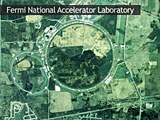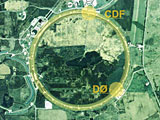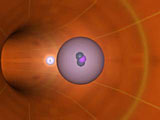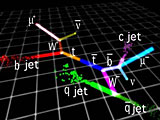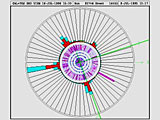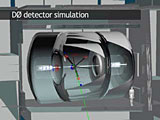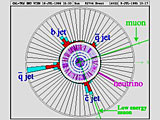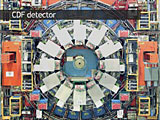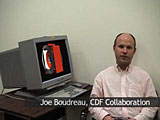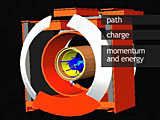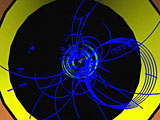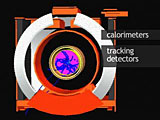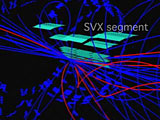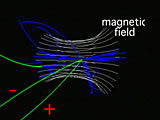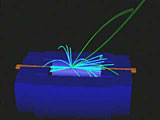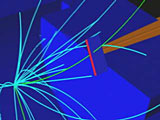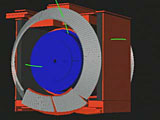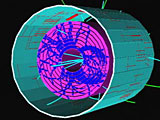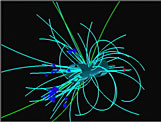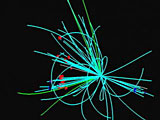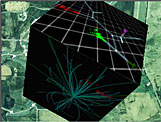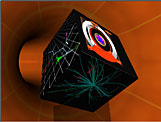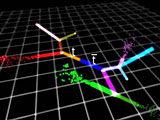
Anatomy of a Detector - Script
What is Fermilab? - Run II Newscasts - Analyze the Data - Online Resources - Site Outline
|
|
We are flying over Fermilab’s accelerator complex. |
|
|
Two collider detectors: CDF and DØ are located along the main ring tunnel (in yellow). |
|
|
Dropping into the tunnel, we can see a proton traveling at nearly the speed of light inside the beam pipe. An antiproton passes by in the opposite direction at the same speed. Occasionally, the proton and antiproton collide violently. |
|
|
Sometimes, as shown in this artist’s rendition, the collision creates rarely seen particles like this top-antitop quark pair. These are unstable so they decay instantly into more conventional forms of matter: charged and neutral particles that move away from the collision. The top and anti-top quark decayed into W bosons and b quarks which in turn decayed into muons, neutrinos, and sprays of particles called jets. |
|
|
Physicists take "snapshots" of these events with special cameras called detectors. |
|
|
We observe the particle debris and work backwards, inferring the presence of rare and unstable parents from their lighter and more conventional offspring. |
|
|
I am using a new Virtual Reality tool that lets physicists reconstruct what happened in collisions in these detectors. |
|
|
Today I am using this same tool to show you the different parts of the detector and how they are used to trace the path, identify the charge and measure the momentum and energy of the particles in the debris of the collision. |
|
|
This is how an event looks with the VR tools. The colored lines are the particle paths. |
|
|
To record events, detectors have many components–basically two types: tracking detectors allow particles to pass undisturbed and calorimeters catch the particles. In the CDF detector, there are two tracking detectors, one very close to the collision point and another on the outside of the detector. |
|
|
The most precise detector lies as close to the collision point as possible where we see the particle tracks. The SVX detector is about a centimeter from the collision point. |
|
|
Let’s zoom in and see the details. Even at this short distance, we are only able to see the decay products of short-lived particles such as top and bottom quarks. By the time it reaches the SVX, the top quark has decayed into many particles. If we look deep into this event, we can see the evidence of the b quark at a short distance from the collision point. |
|
|
Outside the SVX is the outer tracking chamber. |
|
|
The detector has magnets that make the path of charged particles curve. Positively charged particles bend one way and negatively charged particles bend the other. We can tell the charge of the particle by the way it bends. The tracks of higher-energy particles curve less than those of low-energy particles. We can measure the momentum of the particles by looking at the curve of the particle tracks in the magnetic field. |
|
|
Once we have nailed down the trajectories of the particles close to the collision point, we add another type of detector, a calorimeter. Let's display half of the cylindrical calorimeter so we can see the particle tracks. The blue part appears solid but is made of many alternating layers of metal and energy detectors. The metal layers absorb some of particle energy. Cells in the energy detector layers collect light created by the particles as they move though the cell. |
|
|
We can determine the energy of the particle by adding up the signals from each cell. Here I am showing only one of the cells in which energy was observed. We can distinguish between different types of particles such as pions and electrons by noting in which cells they deposit their energy. It is here that we can detect the neutral particles that left no trace in the tracking detector. |
|
|
The only particles that can travel beyond the calorimeter are muons and neutrinos. Here’s our second tracking detector to detect the muons outside the shield. It wraps around the entire detector. Here’s a muon observed in this tracker. Any neutrinos escape unscathed outside the detector passing through the heavy metal of the calorimeters. We infer the existence and energy of the neutrinos in an event by using the concept of conservation of energy. |
|
|
Here is our whole event and the detector. You can see where the particles leave their trace in the detector. Let's zoom in and out of the event and see data in various components of the detector. We can turn off parts of the detector so we can more easily view data of interest. |
|
|
As a whole the detector brings many pieces of information together so we can see the whole event. When we put all the information together, we are able to identify the particles in the event and measure their energies, momenta and charge. Like detectives, we reconstruct what particles were made by the collision and how they decayed into other more-stable particles as they traveled through the detector. If we are lucky, we find a rare event such as the production of a top-antitop quark pair. |
| This streamed program was produced by graduate student Liubo Borissov with Joe Boudreau and the Fermilab Education Office and published by Fermilab's Visual Media Services. | |
